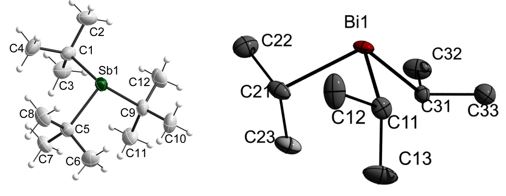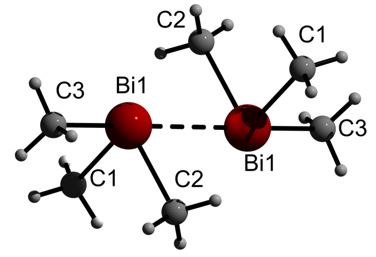Organometallic complexes of group 15 metals (Sb, Bi)
Organometallic complexes of group 15 metals (Sb, Bi)
Trialkylbismuthines BiR3 have initially been reported by Marquardt in 1887, who synthesized Me3Bi and Et3Bi by reaction of BiBr3 and ZnR2.[1] Since then, alternate synthetic pathways have been established. Trialkylbismuthines are weak Lewis bases, since their electron lone pair exhibits high s-character. As a consequence, the number of transition metal and main group metal complexes of bismuthines is much smaller compared to the corresponding amine and phosphine complexes.[2] In addition, trialkylbismuthines have been used as Bi-source in MOCVD reactions for the deposition of bismuth-containing films, in particular Me3Bi due to its high volatility.[3]
Unfortunately, only Bi[CH(SiMe3)2]3 and Bi(CH2SiMe3)3 have been structurally characterized in the solid state.[4] In addition, the solid state structure of Me5Bi was reported.[5] The lack of structural data can be explained by the fact, that most trialkylbismuthines are liquid at ambient temperature, hence complicating the growth of suitable single crystals. We successfully used an IR-laser-assisted technique for the in-situ growth of single crystals directly on the diffractometer in a closed quartz glass capillary under an inert argon atmosphere. The IR-laser allowed a very controlled and focused heating of the sample, which is frozen in a nitrogen steam, hence resulting in optimized growth conditions, in which the sample re-crystallizes without decomposition. Using this techniques, we determined the solid state structures of Me3Bi and i-Pr3Bi.[7] The average Bi-C bond length (Me3Bi 2.259(17) Å; i-Pr3Bi 2.287(9) Å) and the sum of the C-Bi-C bond angles (Me3Bi 276.6(24)°; i-Pr3Bi 290.6(9)°) clearly reflect the different steric requirements of the alkyl groups. According to these parameters, the sterical size increases in the following order: Me < CH2SiMe3 < CHMe2 (i-Pr) < CH(SiMe3)2.
Me3Bi forms a centro-symmetric dimer via an intermolecular Bi···Bi contact (3.899(1) Å), that is shorter than the sum of the van-der-Waals radii (4.318(1) Å). However, the intermolecular distance is slightly longer than intermolecular Bi···Bi interactions as-observed in thermochromic dibismuthines Bi2R4, which typically range from 3.5 to 3.8 Å. In contrast, i-Pr3Bi forms isolated molecules in the solid state without short Bi···Bi contacts to neighboring molecules. Obviously, the sterically less demanding Me substituents in Me3Bi favor the formation of attractive intermolecular Bi···Bi interactions. According to quantum chemical calculations, the main factors for the formation of zig-zag chains of antiparallel BiMe3 monomers in the crystal are Bi···Bi interactions at one end and the accumulation of Me···Me interactions at the other end of the molecule. Between the chains, there are somewhat weaker, yet still significant interactions.
References
[1] A. Marquardt, Ber. 1887, 20, 1516.
[2] a) C. Silvestru, H. J. Breunig, H. Althaus, Chem. Rev. 1999, 99, 3277; b) H. J. Breunig, I. Ghesner, Adv. Organomet. Chem. 2003, 49, 95; c) W. Levason, G. Reid, Coord. Chem. Rev. 2006, 250, 2565.
[3] a) M. Vehkamäki, T. Hatanpää, M.Ritala, M. Leskelä, J. Mater. Chem. 2004, 14, 3191; b) S.-W. Kang, K.-M. Jeon, J.-S. Shin, J.-R. Chun, Y.-H. Kim, S. J. Lee, J.-Y. Yun, Chem. Vap. Deposition 2013, 19, 1.
[4] a) B. Murray, J. Hvoslef, H. Hope, P. P. Power, Inorg. Chem. 1983, 22, 3421; b) J. Harjuoja, T. Hatanpää, M. Vehkamäki, S. Väyrynen, M. Putkonen, L. Niinistö, M. Ritala, M. Leskelä, E. Rauhala, Chem. Vap. Deposition 2005, 11, 362.
[5] S. Wallenhauer, K. Seppelt, Angew. Chem. Int. Ed. 1994, 33, 976.
[7] S. Schulz, A. Kuczkowski, D. Bläser, C. Wölper, G. Jansen, R. Haack, Organometallics 2013, 32, 5445.


